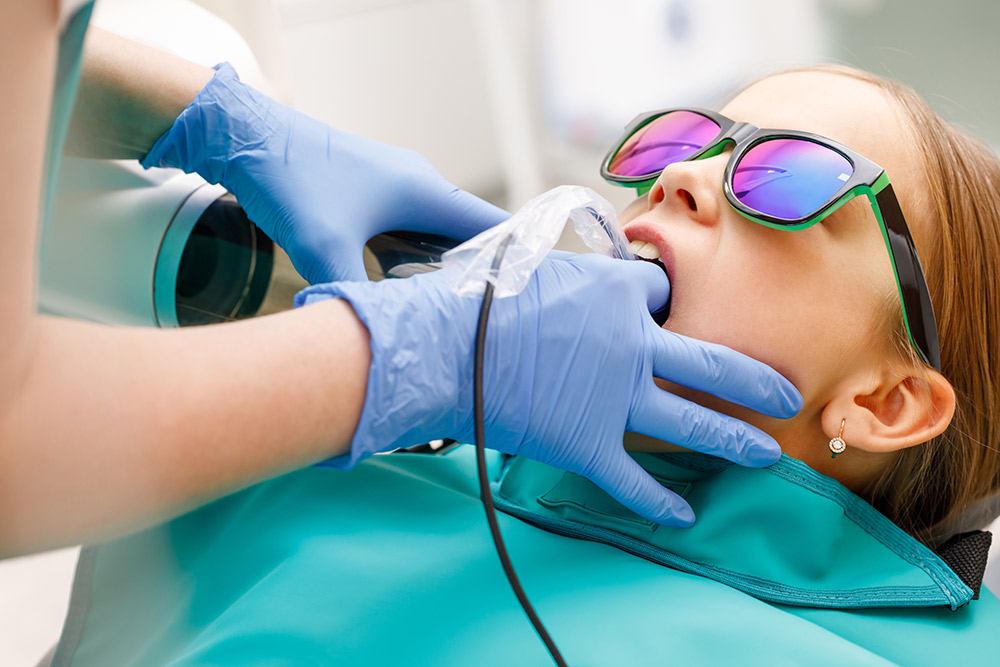How Safe Are X-Rays for My Child?

As your child’s mouth grows and changes, a visual examination alone cannot tell us everything we need to know. X-rays offer a safe and valuable diagnostic tool to help us uncover problems in your child’s teeth that are not visible to the naked eye. At Hurst Pediatric Dentistry, we utilize cutting-edge digital x-ray equipment, designed with patients’ safety and wellbeing in mind. We invite you to experience pediatric dental care at its best!
What Do X-Rays Reveal?
Dental x-rays, also known as radiographs, are an essential part of your child’s dental care treatment plan. They are useful from both a diagnostic perspective (i.e., they help us diagnose problems) and a preventative perspective (i.e., they help us prevent problems). They help us to detect cavities, evaluate the formation of permanent teeth, examine tooth damage, diagnose bone diseases or injuries, and plan orthodontic treatments. When x-rays allow us to identify potential problems in their early stages, we can often address them before they progress and require more extensive restorative treatments.
How Often Do Children Need X-Rays?
At Hurst Pediatric Dentistry, we determine the frequency of x-rays based on your child’s individualized needs and are always mindful about minimizing your child’s exposure to radiation. Generally, children require x-rays more frequently than adults since their mouths are still growing. The American Academy of Pediatric Dentistry recommends x-rays every six months for children with a high risk of tooth decay; children with a low risk of decay require fewer x-rays.
How Safe Are X-Rays for Children?
Today’s advances in technology make x-rays much safer for children than in the past. In fact, according to the American Academy of Pediatric Dentistry, dental x-rays pose a far smaller risk than undetected and untreated dental problems. At Hurst Pediatric Dentistry, we use the latest low radiation, high-speed digital x-ray equipment, which greatly decreases the radiation exposure as compared to traditional film x-rays. In addition, we adhere to safety protocols, including the use of lead body aprons and shields, to minimize your child’s exposure to radiation.
How Can You Minimize the Need for X-Rays?
Make sure your child practices proper oral hygiene practices at home. Encourage brushing at least twice a day for two minutes and flossing between the teeth daily. It’s also important to visit Hurst Pediatric Dentistry as recommended to ensure any condition is diagnosed early on when easiest to treat.
Board-Certified Pediatric Dentist in Hurst, TX
Contact Hurst Pediatric Dentistry to learn more about dental x-rays and how they contribute to your child’s healthy smile. We are happy to answer your questions and address your concerns if you give our office a call at (817) 510-6400. You can always trust that your child’s safety is our top priority.
Hurst Pediatric Dentistry’s Dr. Lin is a board-certified pediatric dentist who treats children from Hurst, Bedford, Euless, North Richland Hills, Watauga, Keller, Haltom City, Colleyville, Arlington, Irving, Fort Worth and the surrounding areas.
This article is intended to provide general information about oral health topics. It should not be used to diagnose or treat any medical condition or as a substitute for the advice of a healthcare professional who is fully aware of and familiar with the specifics of your case. Always seek the advice of your dentist or other qualified healthcare provider with regard to any questions you may have relating to a medical condition or treatment.
MEDICALLY REVIEWED BY:
Dr. Jin Lin

Dr. Jin Lin is a board-certified pediatric dentist with a passion for helping children achieve healthier, more beautiful smiles. He earned his Bachelor of Science degree from Cornell University and his Doctor of Dental Medicine (D.M.D.) degree from the Harvard School of Dental Medicine. After graduating cum laude from dental school, he completed his post-doctoral pediatric dentistry training at Boston Children’s Hospital and the Harvard School of Dental Medicine, where he served as chief resident and worked with children with a wide variety of special medical and dental needs, including children with rare syndromes.

